Report on Leyland Motors: Operation and Project Management Strategies
VerifiedAdded on 2020/07/23
|13
|4043
|74
Report
AI Summary
This report provides a comprehensive analysis of Leyland Motors' operations and project management strategies. It begins by defining operation management and its significance in achieving company goals, followed by a review and critique of operational management principles. The report then focuses on preparing a continuous improvement plan based on these principles, emphasizing the importance of promotional events, after-sales services, and employee relations. Furthermore, the report explores the application and effectiveness of the product life cycle stages within Leyland Motors. Key concepts such as Six Sigma and Lean principles are discussed as tools for improving quality and efficiency. The report concludes by highlighting the importance of continuous improvement for maintaining customer satisfaction, increasing profitability, and fostering innovation within the organization.
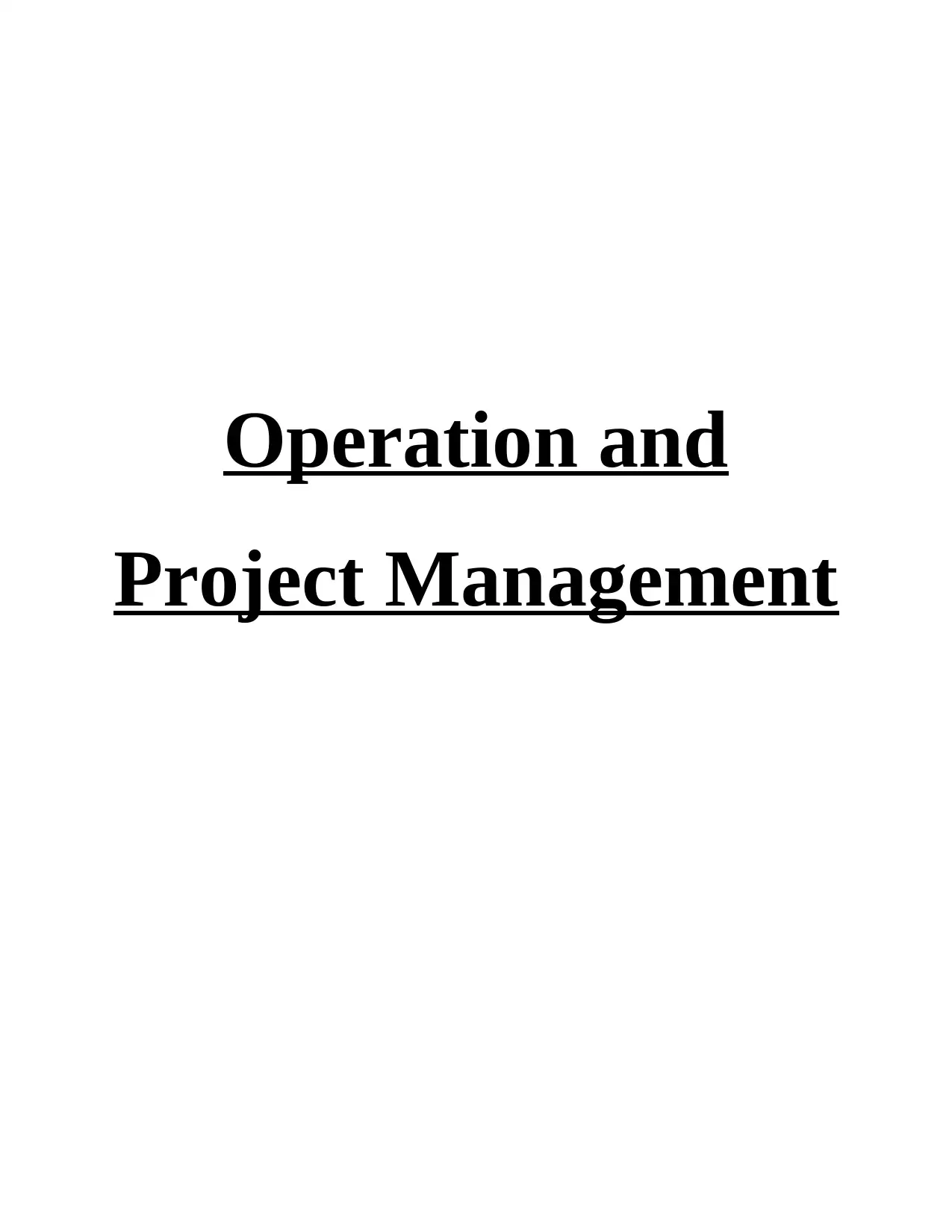
Operation and
Project Management
Project Management
Paraphrase This Document
Need a fresh take? Get an instant paraphrase of this document with our AI Paraphraser
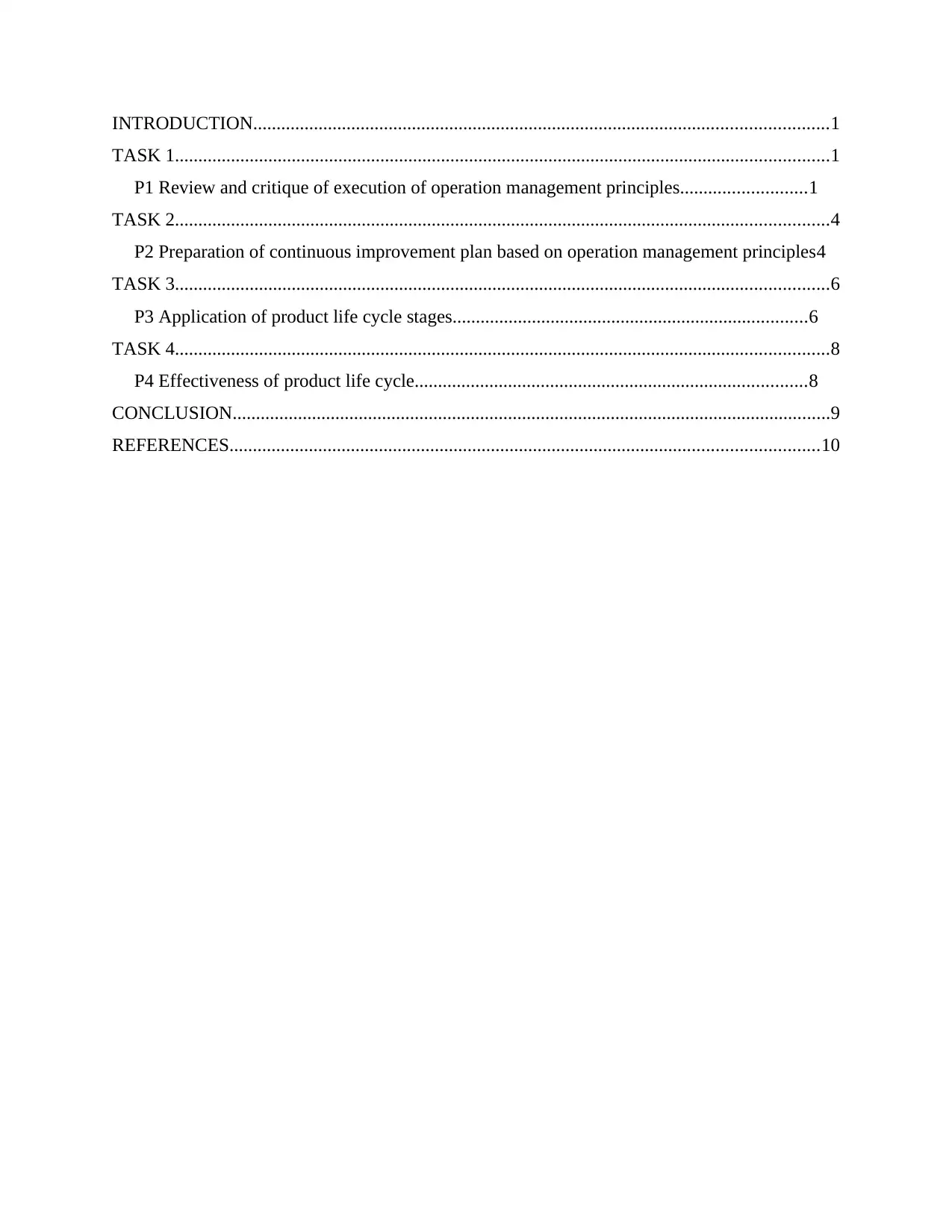
INTRODUCTION...........................................................................................................................1
TASK 1............................................................................................................................................1
P1 Review and critique of execution of operation management principles...........................1
TASK 2............................................................................................................................................4
P2 Preparation of continuous improvement plan based on operation management principles4
TASK 3............................................................................................................................................6
P3 Application of product life cycle stages............................................................................6
TASK 4............................................................................................................................................8
P4 Effectiveness of product life cycle....................................................................................8
CONCLUSION................................................................................................................................9
REFERENCES..............................................................................................................................10
TASK 1............................................................................................................................................1
P1 Review and critique of execution of operation management principles...........................1
TASK 2............................................................................................................................................4
P2 Preparation of continuous improvement plan based on operation management principles4
TASK 3............................................................................................................................................6
P3 Application of product life cycle stages............................................................................6
TASK 4............................................................................................................................................8
P4 Effectiveness of product life cycle....................................................................................8
CONCLUSION................................................................................................................................9
REFERENCES..............................................................................................................................10
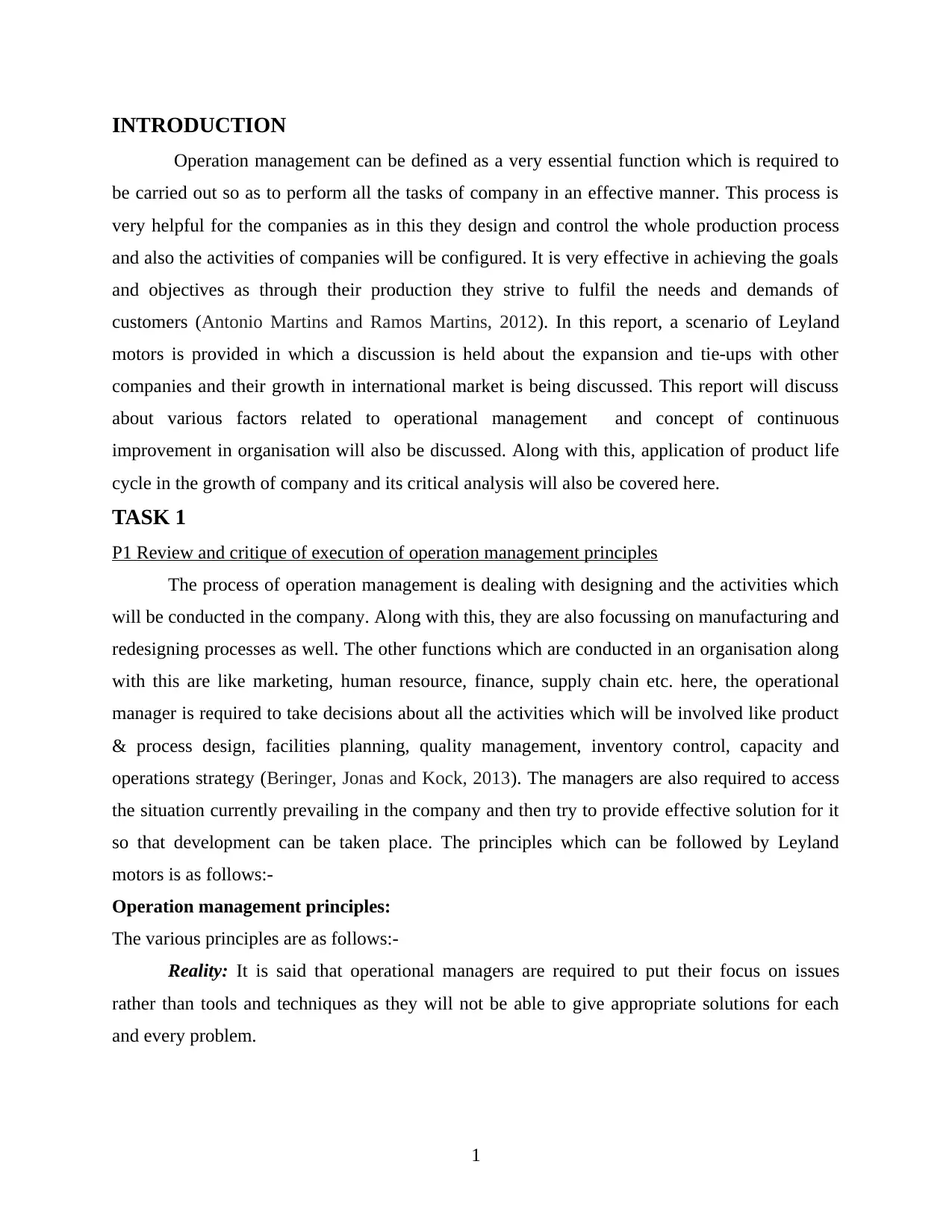
INTRODUCTION
Operation management can be defined as a very essential function which is required to
be carried out so as to perform all the tasks of company in an effective manner. This process is
very helpful for the companies as in this they design and control the whole production process
and also the activities of companies will be configured. It is very effective in achieving the goals
and objectives as through their production they strive to fulfil the needs and demands of
customers (Antonio Martins and Ramos Martins, 2012). In this report, a scenario of Leyland
motors is provided in which a discussion is held about the expansion and tie-ups with other
companies and their growth in international market is being discussed. This report will discuss
about various factors related to operational management and concept of continuous
improvement in organisation will also be discussed. Along with this, application of product life
cycle in the growth of company and its critical analysis will also be covered here.
TASK 1
P1 Review and critique of execution of operation management principles
The process of operation management is dealing with designing and the activities which
will be conducted in the company. Along with this, they are also focussing on manufacturing and
redesigning processes as well. The other functions which are conducted in an organisation along
with this are like marketing, human resource, finance, supply chain etc. here, the operational
manager is required to take decisions about all the activities which will be involved like product
& process design, facilities planning, quality management, inventory control, capacity and
operations strategy (Beringer, Jonas and Kock, 2013). The managers are also required to access
the situation currently prevailing in the company and then try to provide effective solution for it
so that development can be taken place. The principles which can be followed by Leyland
motors is as follows:-
Operation management principles:
The various principles are as follows:-
Reality: It is said that operational managers are required to put their focus on issues
rather than tools and techniques as they will not be able to give appropriate solutions for each
and every problem.
1
Operation management can be defined as a very essential function which is required to
be carried out so as to perform all the tasks of company in an effective manner. This process is
very helpful for the companies as in this they design and control the whole production process
and also the activities of companies will be configured. It is very effective in achieving the goals
and objectives as through their production they strive to fulfil the needs and demands of
customers (Antonio Martins and Ramos Martins, 2012). In this report, a scenario of Leyland
motors is provided in which a discussion is held about the expansion and tie-ups with other
companies and their growth in international market is being discussed. This report will discuss
about various factors related to operational management and concept of continuous
improvement in organisation will also be discussed. Along with this, application of product life
cycle in the growth of company and its critical analysis will also be covered here.
TASK 1
P1 Review and critique of execution of operation management principles
The process of operation management is dealing with designing and the activities which
will be conducted in the company. Along with this, they are also focussing on manufacturing and
redesigning processes as well. The other functions which are conducted in an organisation along
with this are like marketing, human resource, finance, supply chain etc. here, the operational
manager is required to take decisions about all the activities which will be involved like product
& process design, facilities planning, quality management, inventory control, capacity and
operations strategy (Beringer, Jonas and Kock, 2013). The managers are also required to access
the situation currently prevailing in the company and then try to provide effective solution for it
so that development can be taken place. The principles which can be followed by Leyland
motors is as follows:-
Operation management principles:
The various principles are as follows:-
Reality: It is said that operational managers are required to put their focus on issues
rather than tools and techniques as they will not be able to give appropriate solutions for each
and every problem.
1
⊘ This is a preview!⊘
Do you want full access?
Subscribe today to unlock all pages.

Trusted by 1+ million students worldwide
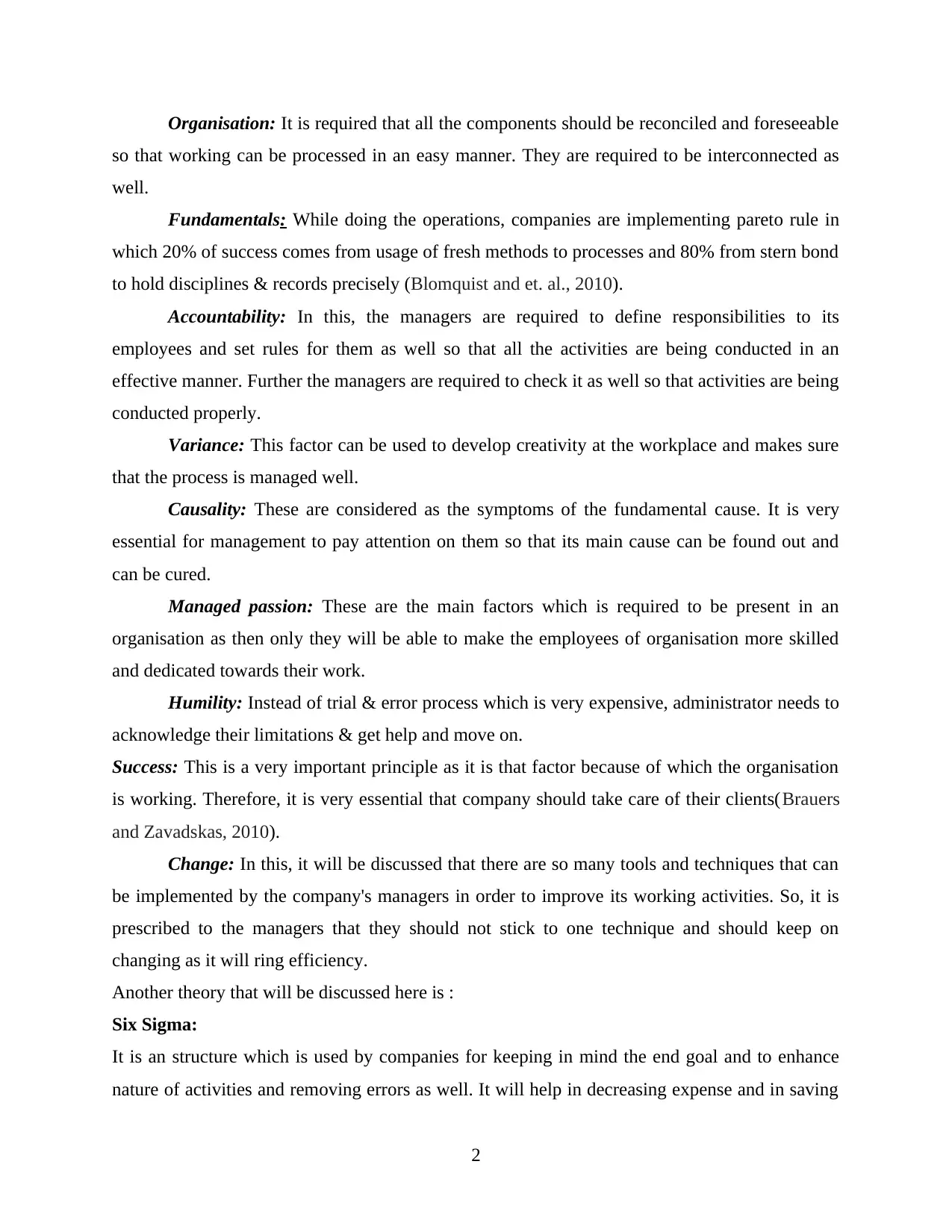
Organisation: It is required that all the components should be reconciled and foreseeable
so that working can be processed in an easy manner. They are required to be interconnected as
well.
Fundamentals: While doing the operations, companies are implementing pareto rule in
which 20% of success comes from usage of fresh methods to processes and 80% from stern bond
to hold disciplines & records precisely (Blomquist and et. al., 2010).
Accountability: In this, the managers are required to define responsibilities to its
employees and set rules for them as well so that all the activities are being conducted in an
effective manner. Further the managers are required to check it as well so that activities are being
conducted properly.
Variance: This factor can be used to develop creativity at the workplace and makes sure
that the process is managed well.
Causality: These are considered as the symptoms of the fundamental cause. It is very
essential for management to pay attention on them so that its main cause can be found out and
can be cured.
Managed passion: These are the main factors which is required to be present in an
organisation as then only they will be able to make the employees of organisation more skilled
and dedicated towards their work.
Humility: Instead of trial & error process which is very expensive, administrator needs to
acknowledge their limitations & get help and move on.
Success: This is a very important principle as it is that factor because of which the organisation
is working. Therefore, it is very essential that company should take care of their clients(Brauers
and Zavadskas, 2010).
Change: In this, it will be discussed that there are so many tools and techniques that can
be implemented by the company's managers in order to improve its working activities. So, it is
prescribed to the managers that they should not stick to one technique and should keep on
changing as it will ring efficiency.
Another theory that will be discussed here is :
Six Sigma:
It is an structure which is used by companies for keeping in mind the end goal and to enhance
nature of activities and removing errors as well. It will help in decreasing expense and in saving
2
so that working can be processed in an easy manner. They are required to be interconnected as
well.
Fundamentals: While doing the operations, companies are implementing pareto rule in
which 20% of success comes from usage of fresh methods to processes and 80% from stern bond
to hold disciplines & records precisely (Blomquist and et. al., 2010).
Accountability: In this, the managers are required to define responsibilities to its
employees and set rules for them as well so that all the activities are being conducted in an
effective manner. Further the managers are required to check it as well so that activities are being
conducted properly.
Variance: This factor can be used to develop creativity at the workplace and makes sure
that the process is managed well.
Causality: These are considered as the symptoms of the fundamental cause. It is very
essential for management to pay attention on them so that its main cause can be found out and
can be cured.
Managed passion: These are the main factors which is required to be present in an
organisation as then only they will be able to make the employees of organisation more skilled
and dedicated towards their work.
Humility: Instead of trial & error process which is very expensive, administrator needs to
acknowledge their limitations & get help and move on.
Success: This is a very important principle as it is that factor because of which the organisation
is working. Therefore, it is very essential that company should take care of their clients(Brauers
and Zavadskas, 2010).
Change: In this, it will be discussed that there are so many tools and techniques that can
be implemented by the company's managers in order to improve its working activities. So, it is
prescribed to the managers that they should not stick to one technique and should keep on
changing as it will ring efficiency.
Another theory that will be discussed here is :
Six Sigma:
It is an structure which is used by companies for keeping in mind the end goal and to enhance
nature of activities and removing errors as well. It will help in decreasing expense and in saving
2
Paraphrase This Document
Need a fresh take? Get an instant paraphrase of this document with our AI Paraphraser
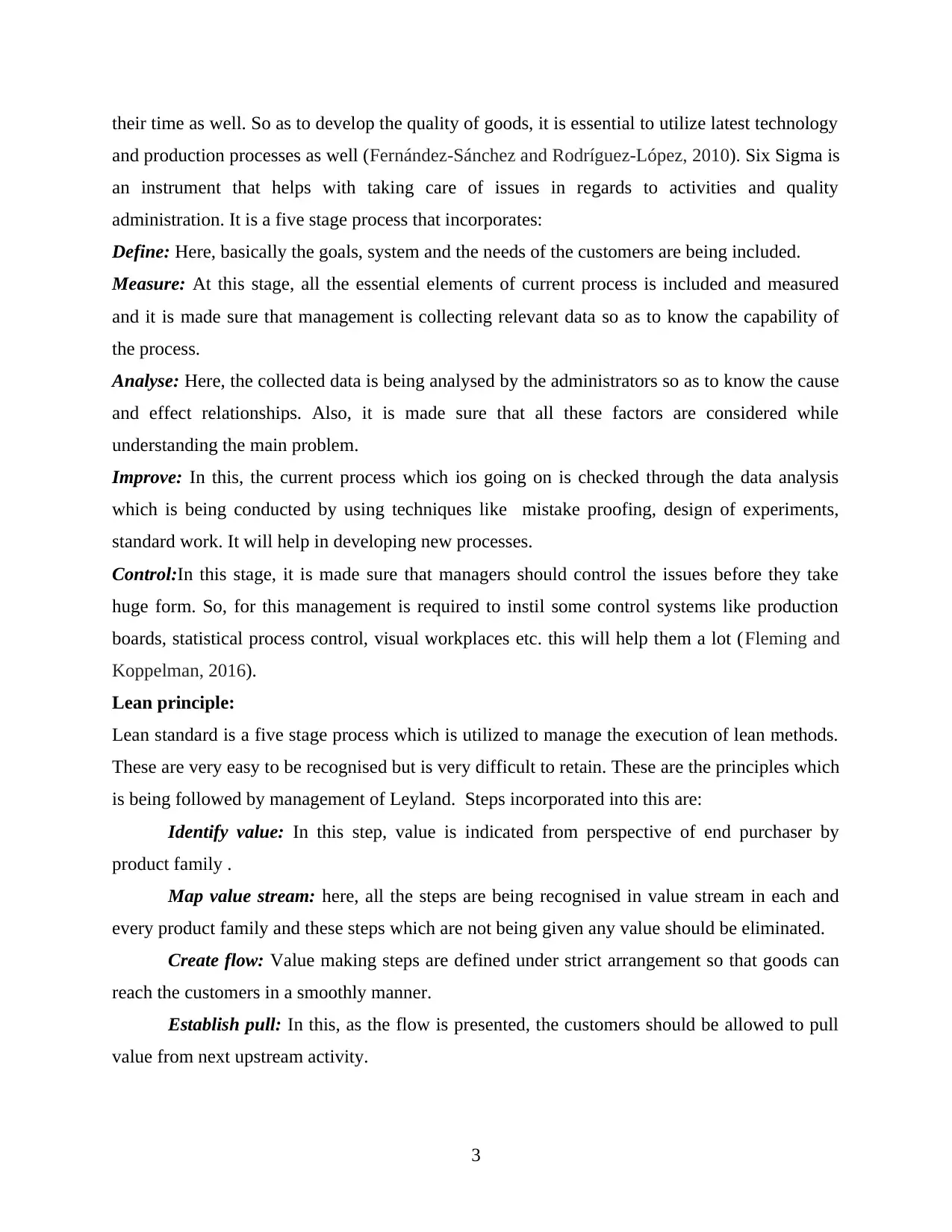
their time as well. So as to develop the quality of goods, it is essential to utilize latest technology
and production processes as well (Fernández-Sánchez and Rodríguez-López, 2010). Six Sigma is
an instrument that helps with taking care of issues in regards to activities and quality
administration. It is a five stage process that incorporates:
Define: Here, basically the goals, system and the needs of the customers are being included.
Measure: At this stage, all the essential elements of current process is included and measured
and it is made sure that management is collecting relevant data so as to know the capability of
the process.
Analyse: Here, the collected data is being analysed by the administrators so as to know the cause
and effect relationships. Also, it is made sure that all these factors are considered while
understanding the main problem.
Improve: In this, the current process which ios going on is checked through the data analysis
which is being conducted by using techniques like mistake proofing, design of experiments,
standard work. It will help in developing new processes.
Control:In this stage, it is made sure that managers should control the issues before they take
huge form. So, for this management is required to instil some control systems like production
boards, statistical process control, visual workplaces etc. this will help them a lot (Fleming and
Koppelman, 2016).
Lean principle:
Lean standard is a five stage process which is utilized to manage the execution of lean methods.
These are very easy to be recognised but is very difficult to retain. These are the principles which
is being followed by management of Leyland. Steps incorporated into this are:
Identify value: In this step, value is indicated from perspective of end purchaser by
product family .
Map value stream: here, all the steps are being recognised in value stream in each and
every product family and these steps which are not being given any value should be eliminated.
Create flow: Value making steps are defined under strict arrangement so that goods can
reach the customers in a smoothly manner.
Establish pull: In this, as the flow is presented, the customers should be allowed to pull
value from next upstream activity.
3
and production processes as well (Fernández-Sánchez and Rodríguez-López, 2010). Six Sigma is
an instrument that helps with taking care of issues in regards to activities and quality
administration. It is a five stage process that incorporates:
Define: Here, basically the goals, system and the needs of the customers are being included.
Measure: At this stage, all the essential elements of current process is included and measured
and it is made sure that management is collecting relevant data so as to know the capability of
the process.
Analyse: Here, the collected data is being analysed by the administrators so as to know the cause
and effect relationships. Also, it is made sure that all these factors are considered while
understanding the main problem.
Improve: In this, the current process which ios going on is checked through the data analysis
which is being conducted by using techniques like mistake proofing, design of experiments,
standard work. It will help in developing new processes.
Control:In this stage, it is made sure that managers should control the issues before they take
huge form. So, for this management is required to instil some control systems like production
boards, statistical process control, visual workplaces etc. this will help them a lot (Fleming and
Koppelman, 2016).
Lean principle:
Lean standard is a five stage process which is utilized to manage the execution of lean methods.
These are very easy to be recognised but is very difficult to retain. These are the principles which
is being followed by management of Leyland. Steps incorporated into this are:
Identify value: In this step, value is indicated from perspective of end purchaser by
product family .
Map value stream: here, all the steps are being recognised in value stream in each and
every product family and these steps which are not being given any value should be eliminated.
Create flow: Value making steps are defined under strict arrangement so that goods can
reach the customers in a smoothly manner.
Establish pull: In this, as the flow is presented, the customers should be allowed to pull
value from next upstream activity.
3
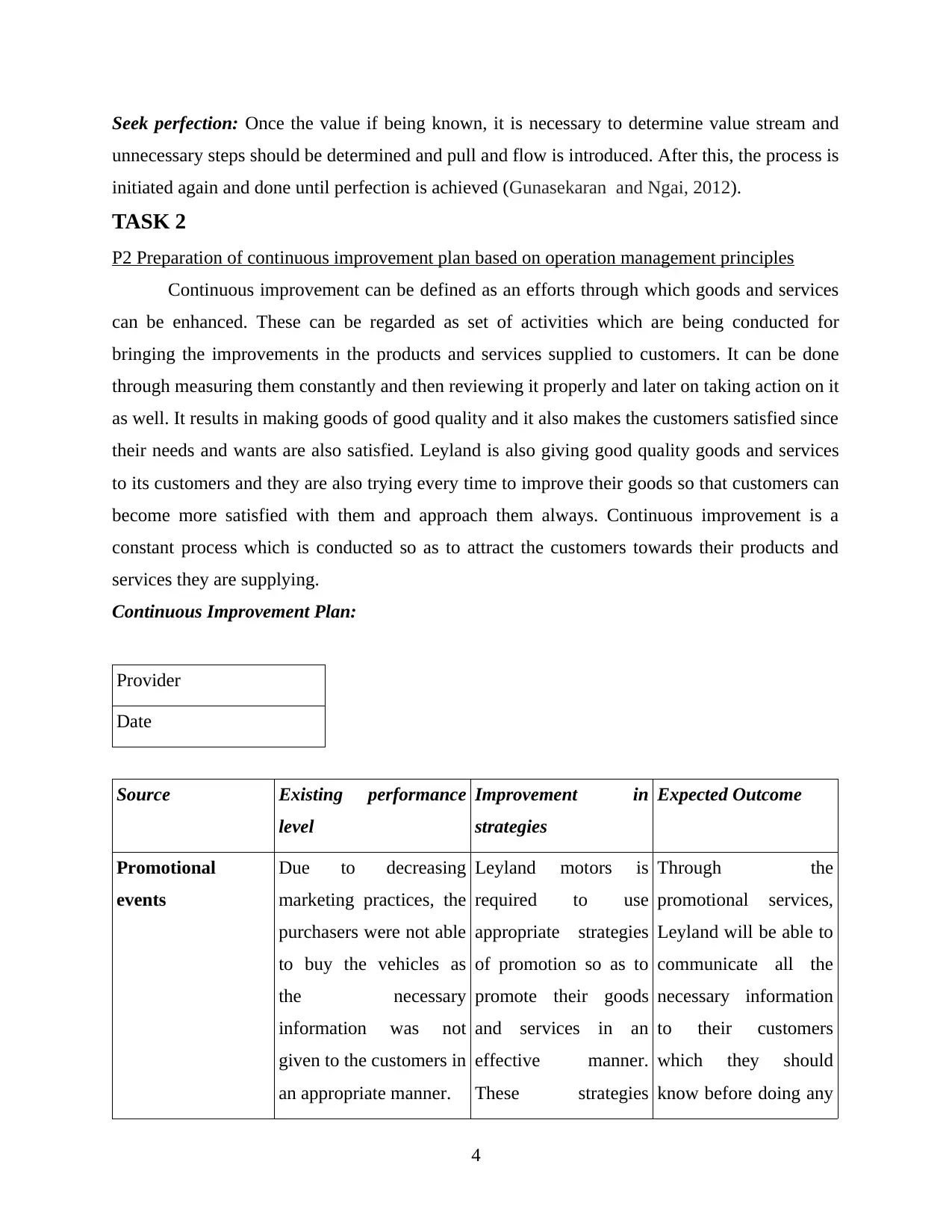
Seek perfection: Once the value if being known, it is necessary to determine value stream and
unnecessary steps should be determined and pull and flow is introduced. After this, the process is
initiated again and done until perfection is achieved (Gunasekaran and Ngai, 2012).
TASK 2
P2 Preparation of continuous improvement plan based on operation management principles
Continuous improvement can be defined as an efforts through which goods and services
can be enhanced. These can be regarded as set of activities which are being conducted for
bringing the improvements in the products and services supplied to customers. It can be done
through measuring them constantly and then reviewing it properly and later on taking action on it
as well. It results in making goods of good quality and it also makes the customers satisfied since
their needs and wants are also satisfied. Leyland is also giving good quality goods and services
to its customers and they are also trying every time to improve their goods so that customers can
become more satisfied with them and approach them always. Continuous improvement is a
constant process which is conducted so as to attract the customers towards their products and
services they are supplying.
Continuous Improvement Plan:
Provider
Date
Source Existing performance
level
Improvement in
strategies
Expected Outcome
Promotional
events
Due to decreasing
marketing practices, the
purchasers were not able
to buy the vehicles as
the necessary
information was not
given to the customers in
an appropriate manner.
Leyland motors is
required to use
appropriate strategies
of promotion so as to
promote their goods
and services in an
effective manner.
These strategies
Through the
promotional services,
Leyland will be able to
communicate all the
necessary information
to their customers
which they should
know before doing any
4
unnecessary steps should be determined and pull and flow is introduced. After this, the process is
initiated again and done until perfection is achieved (Gunasekaran and Ngai, 2012).
TASK 2
P2 Preparation of continuous improvement plan based on operation management principles
Continuous improvement can be defined as an efforts through which goods and services
can be enhanced. These can be regarded as set of activities which are being conducted for
bringing the improvements in the products and services supplied to customers. It can be done
through measuring them constantly and then reviewing it properly and later on taking action on it
as well. It results in making goods of good quality and it also makes the customers satisfied since
their needs and wants are also satisfied. Leyland is also giving good quality goods and services
to its customers and they are also trying every time to improve their goods so that customers can
become more satisfied with them and approach them always. Continuous improvement is a
constant process which is conducted so as to attract the customers towards their products and
services they are supplying.
Continuous Improvement Plan:
Provider
Date
Source Existing performance
level
Improvement in
strategies
Expected Outcome
Promotional
events
Due to decreasing
marketing practices, the
purchasers were not able
to buy the vehicles as
the necessary
information was not
given to the customers in
an appropriate manner.
Leyland motors is
required to use
appropriate strategies
of promotion so as to
promote their goods
and services in an
effective manner.
These strategies
Through the
promotional services,
Leyland will be able to
communicate all the
necessary information
to their customers
which they should
know before doing any
4
⊘ This is a preview!⊘
Do you want full access?
Subscribe today to unlock all pages.

Trusted by 1+ million students worldwide
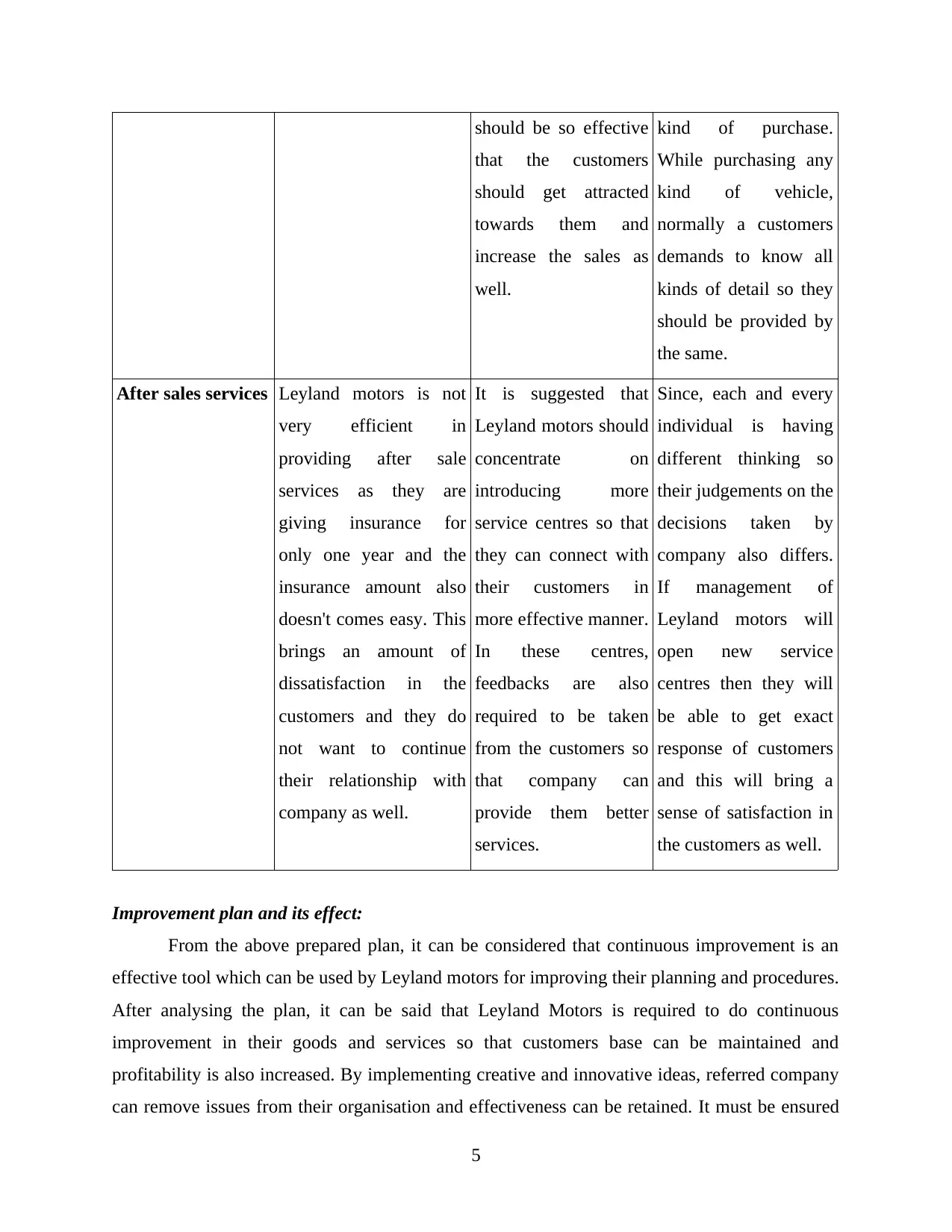
should be so effective
that the customers
should get attracted
towards them and
increase the sales as
well.
kind of purchase.
While purchasing any
kind of vehicle,
normally a customers
demands to know all
kinds of detail so they
should be provided by
the same.
After sales services Leyland motors is not
very efficient in
providing after sale
services as they are
giving insurance for
only one year and the
insurance amount also
doesn't comes easy. This
brings an amount of
dissatisfaction in the
customers and they do
not want to continue
their relationship with
company as well.
It is suggested that
Leyland motors should
concentrate on
introducing more
service centres so that
they can connect with
their customers in
more effective manner.
In these centres,
feedbacks are also
required to be taken
from the customers so
that company can
provide them better
services.
Since, each and every
individual is having
different thinking so
their judgements on the
decisions taken by
company also differs.
If management of
Leyland motors will
open new service
centres then they will
be able to get exact
response of customers
and this will bring a
sense of satisfaction in
the customers as well.
Improvement plan and its effect:
From the above prepared plan, it can be considered that continuous improvement is an
effective tool which can be used by Leyland motors for improving their planning and procedures.
After analysing the plan, it can be said that Leyland Motors is required to do continuous
improvement in their goods and services so that customers base can be maintained and
profitability is also increased. By implementing creative and innovative ideas, referred company
can remove issues from their organisation and effectiveness can be retained. It must be ensured
5
that the customers
should get attracted
towards them and
increase the sales as
well.
kind of purchase.
While purchasing any
kind of vehicle,
normally a customers
demands to know all
kinds of detail so they
should be provided by
the same.
After sales services Leyland motors is not
very efficient in
providing after sale
services as they are
giving insurance for
only one year and the
insurance amount also
doesn't comes easy. This
brings an amount of
dissatisfaction in the
customers and they do
not want to continue
their relationship with
company as well.
It is suggested that
Leyland motors should
concentrate on
introducing more
service centres so that
they can connect with
their customers in
more effective manner.
In these centres,
feedbacks are also
required to be taken
from the customers so
that company can
provide them better
services.
Since, each and every
individual is having
different thinking so
their judgements on the
decisions taken by
company also differs.
If management of
Leyland motors will
open new service
centres then they will
be able to get exact
response of customers
and this will bring a
sense of satisfaction in
the customers as well.
Improvement plan and its effect:
From the above prepared plan, it can be considered that continuous improvement is an
effective tool which can be used by Leyland motors for improving their planning and procedures.
After analysing the plan, it can be said that Leyland Motors is required to do continuous
improvement in their goods and services so that customers base can be maintained and
profitability is also increased. By implementing creative and innovative ideas, referred company
can remove issues from their organisation and effectiveness can be retained. It must be ensured
5
Paraphrase This Document
Need a fresh take? Get an instant paraphrase of this document with our AI Paraphraser
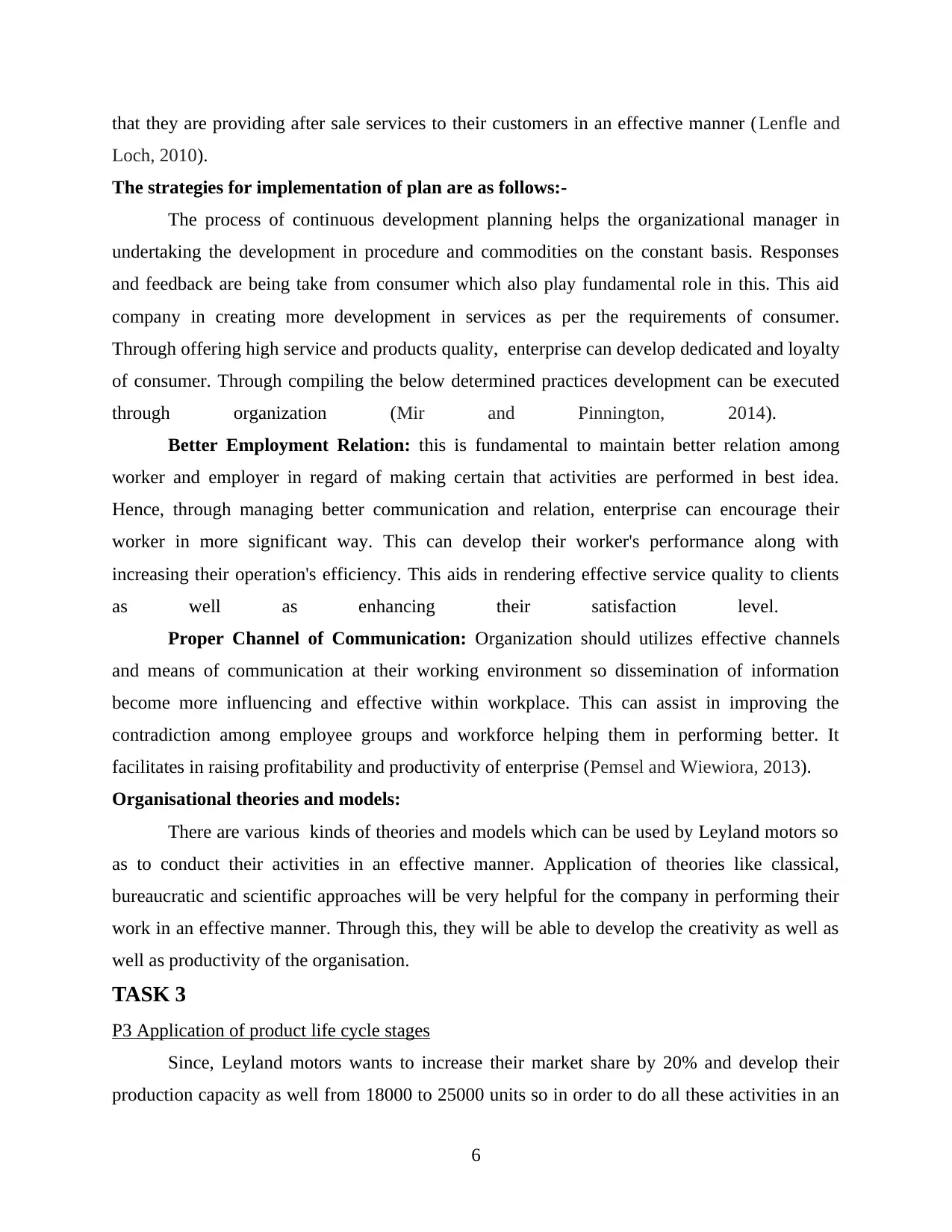
that they are providing after sale services to their customers in an effective manner (Lenfle and
Loch, 2010).
The strategies for implementation of plan are as follows:-
The process of continuous development planning helps the organizational manager in
undertaking the development in procedure and commodities on the constant basis. Responses
and feedback are being take from consumer which also play fundamental role in this. This aid
company in creating more development in services as per the requirements of consumer.
Through offering high service and products quality, enterprise can develop dedicated and loyalty
of consumer. Through compiling the below determined practices development can be executed
through organization (Mir and Pinnington, 2014).
Better Employment Relation: this is fundamental to maintain better relation among
worker and employer in regard of making certain that activities are performed in best idea.
Hence, through managing better communication and relation, enterprise can encourage their
worker in more significant way. This can develop their worker's performance along with
increasing their operation's efficiency. This aids in rendering effective service quality to clients
as well as enhancing their satisfaction level.
Proper Channel of Communication: Organization should utilizes effective channels
and means of communication at their working environment so dissemination of information
become more influencing and effective within workplace. This can assist in improving the
contradiction among employee groups and workforce helping them in performing better. It
facilitates in raising profitability and productivity of enterprise (Pemsel and Wiewiora, 2013).
Organisational theories and models:
There are various kinds of theories and models which can be used by Leyland motors so
as to conduct their activities in an effective manner. Application of theories like classical,
bureaucratic and scientific approaches will be very helpful for the company in performing their
work in an effective manner. Through this, they will be able to develop the creativity as well as
well as productivity of the organisation.
TASK 3
P3 Application of product life cycle stages
Since, Leyland motors wants to increase their market share by 20% and develop their
production capacity as well from 18000 to 25000 units so in order to do all these activities in an
6
Loch, 2010).
The strategies for implementation of plan are as follows:-
The process of continuous development planning helps the organizational manager in
undertaking the development in procedure and commodities on the constant basis. Responses
and feedback are being take from consumer which also play fundamental role in this. This aid
company in creating more development in services as per the requirements of consumer.
Through offering high service and products quality, enterprise can develop dedicated and loyalty
of consumer. Through compiling the below determined practices development can be executed
through organization (Mir and Pinnington, 2014).
Better Employment Relation: this is fundamental to maintain better relation among
worker and employer in regard of making certain that activities are performed in best idea.
Hence, through managing better communication and relation, enterprise can encourage their
worker in more significant way. This can develop their worker's performance along with
increasing their operation's efficiency. This aids in rendering effective service quality to clients
as well as enhancing their satisfaction level.
Proper Channel of Communication: Organization should utilizes effective channels
and means of communication at their working environment so dissemination of information
become more influencing and effective within workplace. This can assist in improving the
contradiction among employee groups and workforce helping them in performing better. It
facilitates in raising profitability and productivity of enterprise (Pemsel and Wiewiora, 2013).
Organisational theories and models:
There are various kinds of theories and models which can be used by Leyland motors so
as to conduct their activities in an effective manner. Application of theories like classical,
bureaucratic and scientific approaches will be very helpful for the company in performing their
work in an effective manner. Through this, they will be able to develop the creativity as well as
well as productivity of the organisation.
TASK 3
P3 Application of product life cycle stages
Since, Leyland motors wants to increase their market share by 20% and develop their
production capacity as well from 18000 to 25000 units so in order to do all these activities in an
6
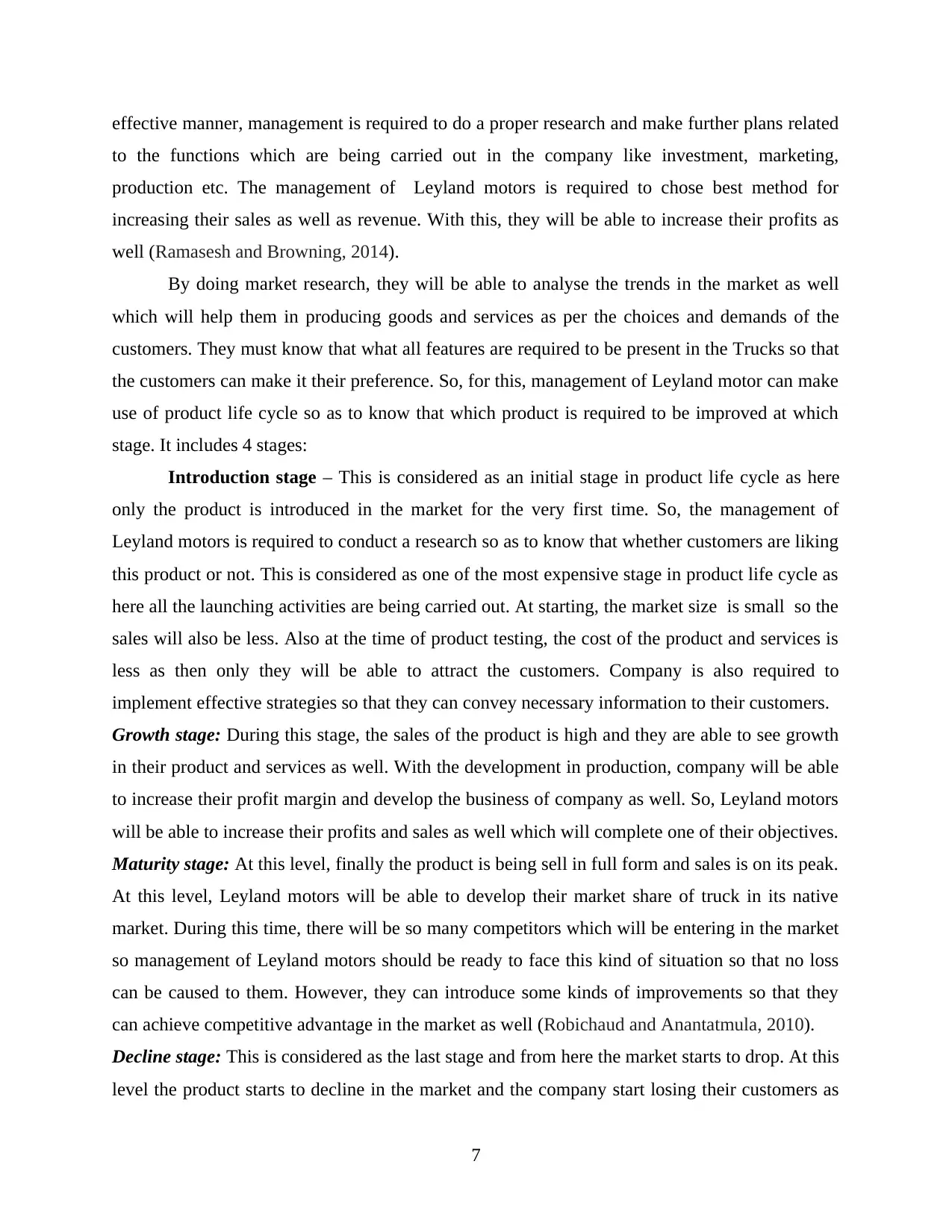
effective manner, management is required to do a proper research and make further plans related
to the functions which are being carried out in the company like investment, marketing,
production etc. The management of Leyland motors is required to chose best method for
increasing their sales as well as revenue. With this, they will be able to increase their profits as
well (Ramasesh and Browning, 2014).
By doing market research, they will be able to analyse the trends in the market as well
which will help them in producing goods and services as per the choices and demands of the
customers. They must know that what all features are required to be present in the Trucks so that
the customers can make it their preference. So, for this, management of Leyland motor can make
use of product life cycle so as to know that which product is required to be improved at which
stage. It includes 4 stages:
Introduction stage – This is considered as an initial stage in product life cycle as here
only the product is introduced in the market for the very first time. So, the management of
Leyland motors is required to conduct a research so as to know that whether customers are liking
this product or not. This is considered as one of the most expensive stage in product life cycle as
here all the launching activities are being carried out. At starting, the market size is small so the
sales will also be less. Also at the time of product testing, the cost of the product and services is
less as then only they will be able to attract the customers. Company is also required to
implement effective strategies so that they can convey necessary information to their customers.
Growth stage: During this stage, the sales of the product is high and they are able to see growth
in their product and services as well. With the development in production, company will be able
to increase their profit margin and develop the business of company as well. So, Leyland motors
will be able to increase their profits and sales as well which will complete one of their objectives.
Maturity stage: At this level, finally the product is being sell in full form and sales is on its peak.
At this level, Leyland motors will be able to develop their market share of truck in its native
market. During this time, there will be so many competitors which will be entering in the market
so management of Leyland motors should be ready to face this kind of situation so that no loss
can be caused to them. However, they can introduce some kinds of improvements so that they
can achieve competitive advantage in the market as well (Robichaud and Anantatmula, 2010).
Decline stage: This is considered as the last stage and from here the market starts to drop. At this
level the product starts to decline in the market and the company start losing their customers as
7
to the functions which are being carried out in the company like investment, marketing,
production etc. The management of Leyland motors is required to chose best method for
increasing their sales as well as revenue. With this, they will be able to increase their profits as
well (Ramasesh and Browning, 2014).
By doing market research, they will be able to analyse the trends in the market as well
which will help them in producing goods and services as per the choices and demands of the
customers. They must know that what all features are required to be present in the Trucks so that
the customers can make it their preference. So, for this, management of Leyland motor can make
use of product life cycle so as to know that which product is required to be improved at which
stage. It includes 4 stages:
Introduction stage – This is considered as an initial stage in product life cycle as here
only the product is introduced in the market for the very first time. So, the management of
Leyland motors is required to conduct a research so as to know that whether customers are liking
this product or not. This is considered as one of the most expensive stage in product life cycle as
here all the launching activities are being carried out. At starting, the market size is small so the
sales will also be less. Also at the time of product testing, the cost of the product and services is
less as then only they will be able to attract the customers. Company is also required to
implement effective strategies so that they can convey necessary information to their customers.
Growth stage: During this stage, the sales of the product is high and they are able to see growth
in their product and services as well. With the development in production, company will be able
to increase their profit margin and develop the business of company as well. So, Leyland motors
will be able to increase their profits and sales as well which will complete one of their objectives.
Maturity stage: At this level, finally the product is being sell in full form and sales is on its peak.
At this level, Leyland motors will be able to develop their market share of truck in its native
market. During this time, there will be so many competitors which will be entering in the market
so management of Leyland motors should be ready to face this kind of situation so that no loss
can be caused to them. However, they can introduce some kinds of improvements so that they
can achieve competitive advantage in the market as well (Robichaud and Anantatmula, 2010).
Decline stage: This is considered as the last stage and from here the market starts to drop. At this
level the product starts to decline in the market and the company start losing their customers as
7
⊘ This is a preview!⊘
Do you want full access?
Subscribe today to unlock all pages.

Trusted by 1+ million students worldwide
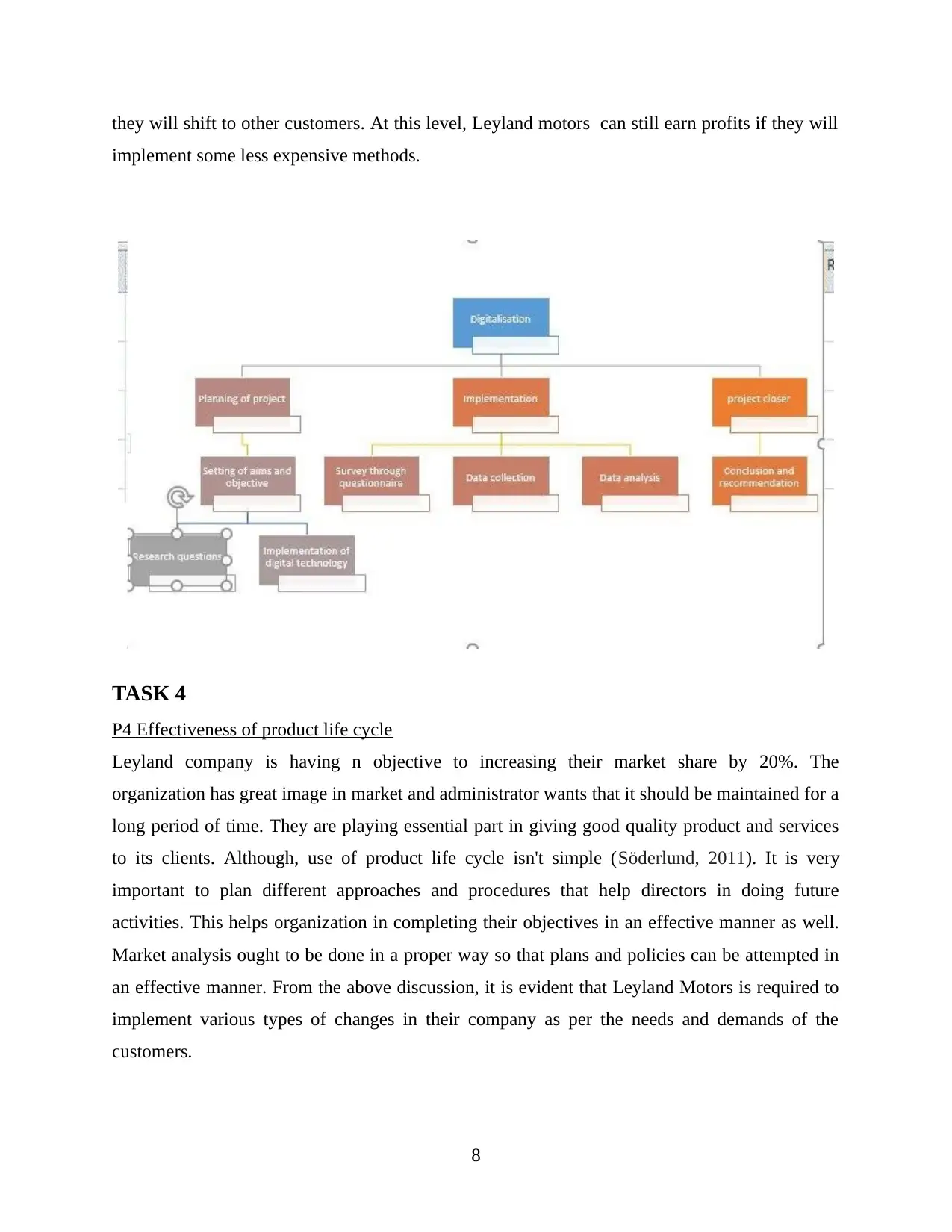
they will shift to other customers. At this level, Leyland motors can still earn profits if they will
implement some less expensive methods.
TASK 4
P4 Effectiveness of product life cycle
Leyland company is having n objective to increasing their market share by 20%. The
organization has great image in market and administrator wants that it should be maintained for a
long period of time. They are playing essential part in giving good quality product and services
to its clients. Although, use of product life cycle isn't simple (Söderlund, 2011). It is very
important to plan different approaches and procedures that help directors in doing future
activities. This helps organization in completing their objectives in an effective manner as well.
Market analysis ought to be done in a proper way so that plans and policies can be attempted in
an effective manner. From the above discussion, it is evident that Leyland Motors is required to
implement various types of changes in their company as per the needs and demands of the
customers.
8
implement some less expensive methods.
TASK 4
P4 Effectiveness of product life cycle
Leyland company is having n objective to increasing their market share by 20%. The
organization has great image in market and administrator wants that it should be maintained for a
long period of time. They are playing essential part in giving good quality product and services
to its clients. Although, use of product life cycle isn't simple (Söderlund, 2011). It is very
important to plan different approaches and procedures that help directors in doing future
activities. This helps organization in completing their objectives in an effective manner as well.
Market analysis ought to be done in a proper way so that plans and policies can be attempted in
an effective manner. From the above discussion, it is evident that Leyland Motors is required to
implement various types of changes in their company as per the needs and demands of the
customers.
8
Paraphrase This Document
Need a fresh take? Get an instant paraphrase of this document with our AI Paraphraser
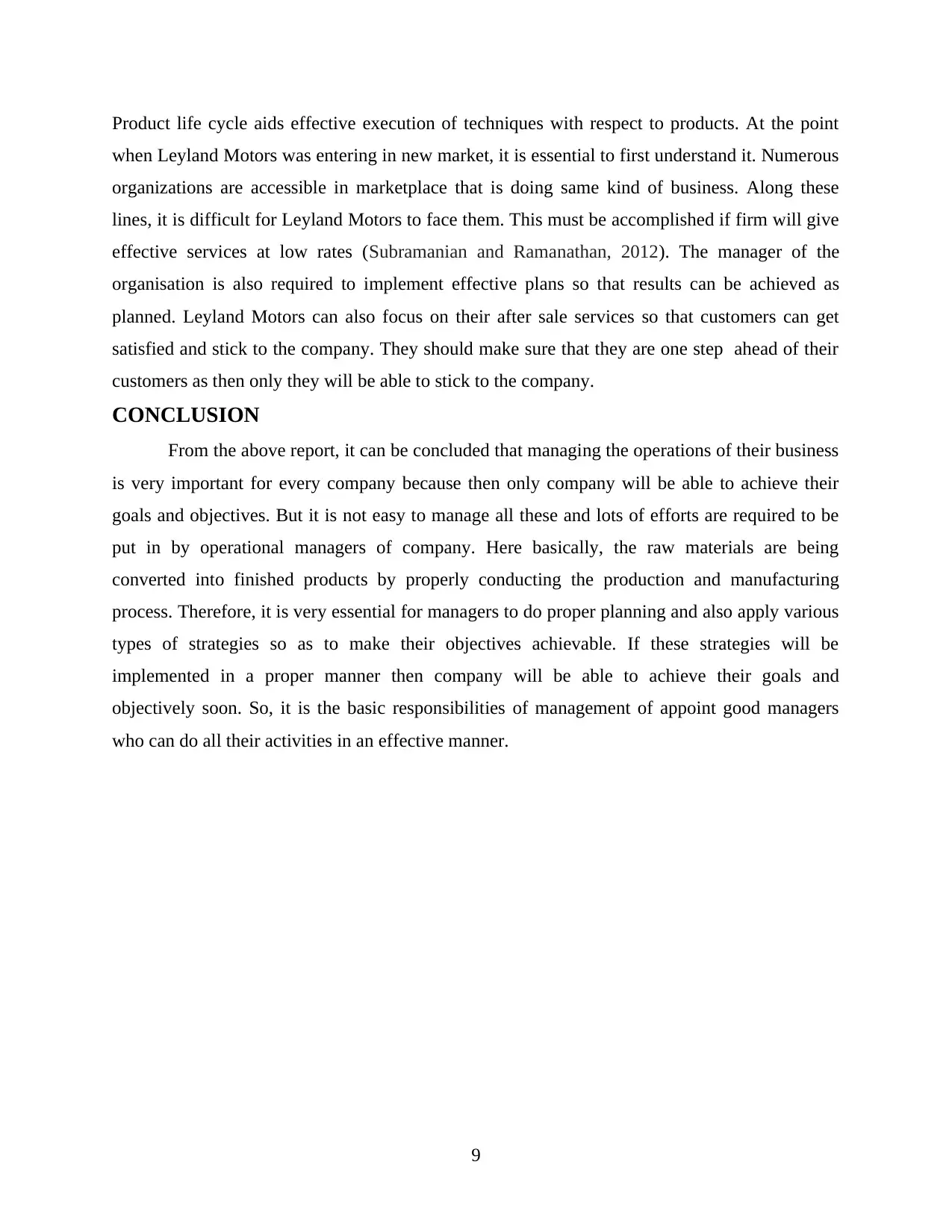
Product life cycle aids effective execution of techniques with respect to products. At the point
when Leyland Motors was entering in new market, it is essential to first understand it. Numerous
organizations are accessible in marketplace that is doing same kind of business. Along these
lines, it is difficult for Leyland Motors to face them. This must be accomplished if firm will give
effective services at low rates (Subramanian and Ramanathan, 2012). The manager of the
organisation is also required to implement effective plans so that results can be achieved as
planned. Leyland Motors can also focus on their after sale services so that customers can get
satisfied and stick to the company. They should make sure that they are one step ahead of their
customers as then only they will be able to stick to the company.
CONCLUSION
From the above report, it can be concluded that managing the operations of their business
is very important for every company because then only company will be able to achieve their
goals and objectives. But it is not easy to manage all these and lots of efforts are required to be
put in by operational managers of company. Here basically, the raw materials are being
converted into finished products by properly conducting the production and manufacturing
process. Therefore, it is very essential for managers to do proper planning and also apply various
types of strategies so as to make their objectives achievable. If these strategies will be
implemented in a proper manner then company will be able to achieve their goals and
objectively soon. So, it is the basic responsibilities of management of appoint good managers
who can do all their activities in an effective manner.
9
when Leyland Motors was entering in new market, it is essential to first understand it. Numerous
organizations are accessible in marketplace that is doing same kind of business. Along these
lines, it is difficult for Leyland Motors to face them. This must be accomplished if firm will give
effective services at low rates (Subramanian and Ramanathan, 2012). The manager of the
organisation is also required to implement effective plans so that results can be achieved as
planned. Leyland Motors can also focus on their after sale services so that customers can get
satisfied and stick to the company. They should make sure that they are one step ahead of their
customers as then only they will be able to stick to the company.
CONCLUSION
From the above report, it can be concluded that managing the operations of their business
is very important for every company because then only company will be able to achieve their
goals and objectives. But it is not easy to manage all these and lots of efforts are required to be
put in by operational managers of company. Here basically, the raw materials are being
converted into finished products by properly conducting the production and manufacturing
process. Therefore, it is very essential for managers to do proper planning and also apply various
types of strategies so as to make their objectives achievable. If these strategies will be
implemented in a proper manner then company will be able to achieve their goals and
objectively soon. So, it is the basic responsibilities of management of appoint good managers
who can do all their activities in an effective manner.
9
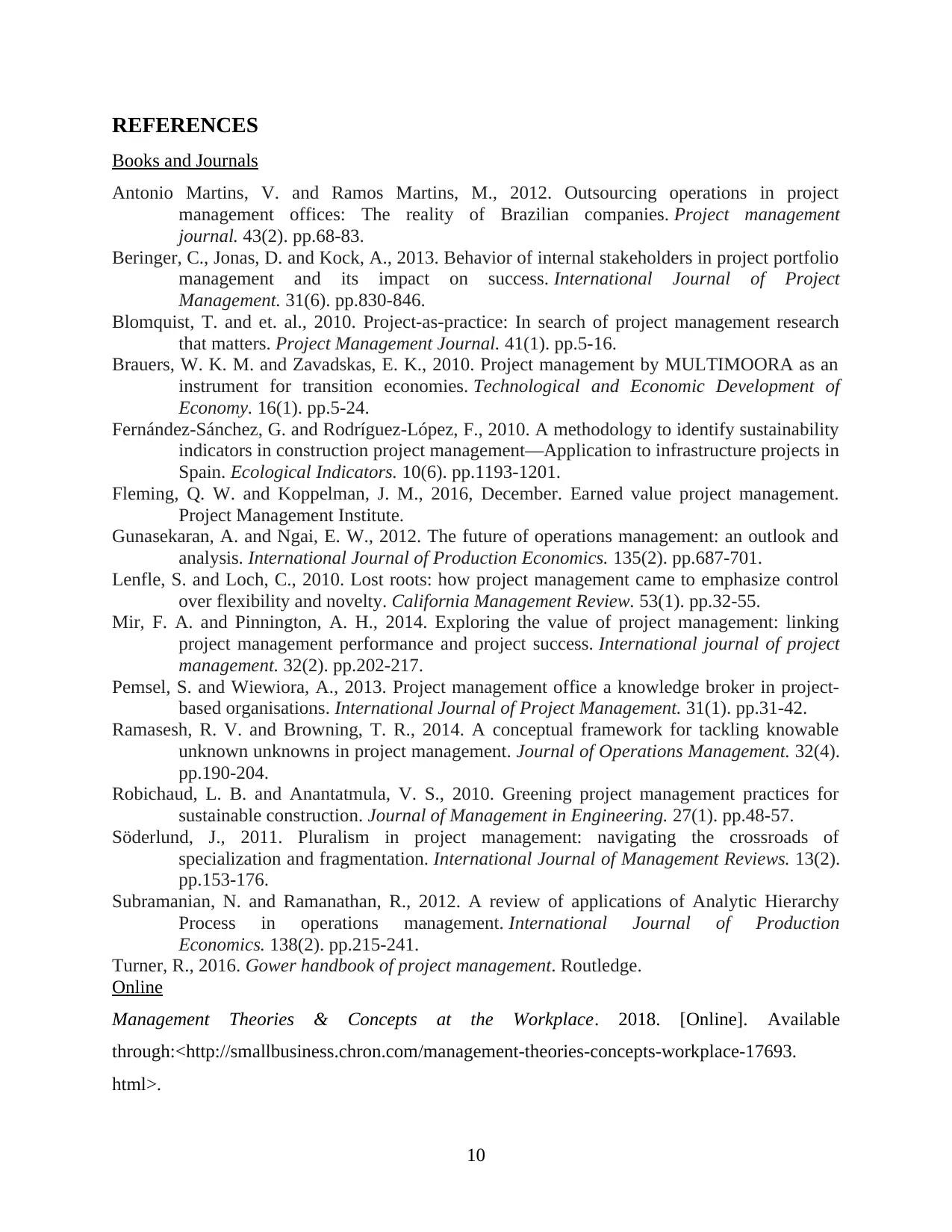
REFERENCES
Books and Journals
Antonio Martins, V. and Ramos Martins, M., 2012. Outsourcing operations in project
management offices: The reality of Brazilian companies. Project management
journal. 43(2). pp.68-83.
Beringer, C., Jonas, D. and Kock, A., 2013. Behavior of internal stakeholders in project portfolio
management and its impact on success. International Journal of Project
Management. 31(6). pp.830-846.
Blomquist, T. and et. al., 2010. Project‐as‐practice: In search of project management research
that matters. Project Management Journal. 41(1). pp.5-16.
Brauers, W. K. M. and Zavadskas, E. K., 2010. Project management by MULTIMOORA as an
instrument for transition economies. Technological and Economic Development of
Economy. 16(1). pp.5-24.
Fernández-Sánchez, G. and Rodríguez-López, F., 2010. A methodology to identify sustainability
indicators in construction project management—Application to infrastructure projects in
Spain. Ecological Indicators. 10(6). pp.1193-1201.
Fleming, Q. W. and Koppelman, J. M., 2016, December. Earned value project management.
Project Management Institute.
Gunasekaran, A. and Ngai, E. W., 2012. The future of operations management: an outlook and
analysis. International Journal of Production Economics. 135(2). pp.687-701.
Lenfle, S. and Loch, C., 2010. Lost roots: how project management came to emphasize control
over flexibility and novelty. California Management Review. 53(1). pp.32-55.
Mir, F. A. and Pinnington, A. H., 2014. Exploring the value of project management: linking
project management performance and project success. International journal of project
management. 32(2). pp.202-217.
Pemsel, S. and Wiewiora, A., 2013. Project management office a knowledge broker in project-
based organisations. International Journal of Project Management. 31(1). pp.31-42.
Ramasesh, R. V. and Browning, T. R., 2014. A conceptual framework for tackling knowable
unknown unknowns in project management. Journal of Operations Management. 32(4).
pp.190-204.
Robichaud, L. B. and Anantatmula, V. S., 2010. Greening project management practices for
sustainable construction. Journal of Management in Engineering. 27(1). pp.48-57.
Söderlund, J., 2011. Pluralism in project management: navigating the crossroads of
specialization and fragmentation. International Journal of Management Reviews. 13(2).
pp.153-176.
Subramanian, N. and Ramanathan, R., 2012. A review of applications of Analytic Hierarchy
Process in operations management. International Journal of Production
Economics. 138(2). pp.215-241.
Turner, R., 2016. Gower handbook of project management. Routledge.
Online
Management Theories & Concepts at the Workplace. 2018. [Online]. Available
through:<http://smallbusiness.chron.com/management-theories-concepts-workplace-17693.
html>.
10
Books and Journals
Antonio Martins, V. and Ramos Martins, M., 2012. Outsourcing operations in project
management offices: The reality of Brazilian companies. Project management
journal. 43(2). pp.68-83.
Beringer, C., Jonas, D. and Kock, A., 2013. Behavior of internal stakeholders in project portfolio
management and its impact on success. International Journal of Project
Management. 31(6). pp.830-846.
Blomquist, T. and et. al., 2010. Project‐as‐practice: In search of project management research
that matters. Project Management Journal. 41(1). pp.5-16.
Brauers, W. K. M. and Zavadskas, E. K., 2010. Project management by MULTIMOORA as an
instrument for transition economies. Technological and Economic Development of
Economy. 16(1). pp.5-24.
Fernández-Sánchez, G. and Rodríguez-López, F., 2010. A methodology to identify sustainability
indicators in construction project management—Application to infrastructure projects in
Spain. Ecological Indicators. 10(6). pp.1193-1201.
Fleming, Q. W. and Koppelman, J. M., 2016, December. Earned value project management.
Project Management Institute.
Gunasekaran, A. and Ngai, E. W., 2012. The future of operations management: an outlook and
analysis. International Journal of Production Economics. 135(2). pp.687-701.
Lenfle, S. and Loch, C., 2010. Lost roots: how project management came to emphasize control
over flexibility and novelty. California Management Review. 53(1). pp.32-55.
Mir, F. A. and Pinnington, A. H., 2014. Exploring the value of project management: linking
project management performance and project success. International journal of project
management. 32(2). pp.202-217.
Pemsel, S. and Wiewiora, A., 2013. Project management office a knowledge broker in project-
based organisations. International Journal of Project Management. 31(1). pp.31-42.
Ramasesh, R. V. and Browning, T. R., 2014. A conceptual framework for tackling knowable
unknown unknowns in project management. Journal of Operations Management. 32(4).
pp.190-204.
Robichaud, L. B. and Anantatmula, V. S., 2010. Greening project management practices for
sustainable construction. Journal of Management in Engineering. 27(1). pp.48-57.
Söderlund, J., 2011. Pluralism in project management: navigating the crossroads of
specialization and fragmentation. International Journal of Management Reviews. 13(2).
pp.153-176.
Subramanian, N. and Ramanathan, R., 2012. A review of applications of Analytic Hierarchy
Process in operations management. International Journal of Production
Economics. 138(2). pp.215-241.
Turner, R., 2016. Gower handbook of project management. Routledge.
Online
Management Theories & Concepts at the Workplace. 2018. [Online]. Available
through:<http://smallbusiness.chron.com/management-theories-concepts-workplace-17693.
html>.
10
⊘ This is a preview!⊘
Do you want full access?
Subscribe today to unlock all pages.

Trusted by 1+ million students worldwide
1 out of 13
Related Documents
Your All-in-One AI-Powered Toolkit for Academic Success.
+13062052269
info@desklib.com
Available 24*7 on WhatsApp / Email
![[object Object]](/_next/static/media/star-bottom.7253800d.svg)
Unlock your academic potential
Copyright © 2020–2025 A2Z Services. All Rights Reserved. Developed and managed by ZUCOL.





